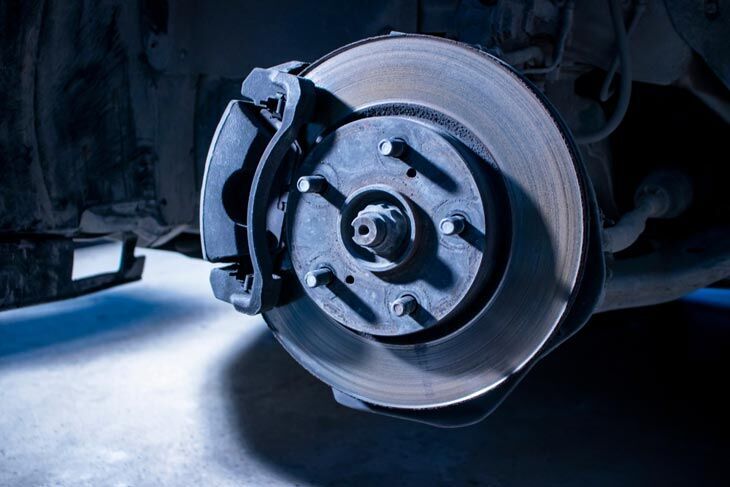
Hvorfor lyder min bil som en helikopter ?
Twisted brake caliper, torn brake rotor, inoperative parking brake, bad brakes, defective wheel bearing, broken fan clutch motors/poor-quality tires, exhaust leak, vacuum leak, faulty catalytic converter, problems with engines, exhaust systems, flywheel, and water Pumpe er blot et par at navngive.
Der er mange andre muligheder, når det kommer til bil, der gør helikopterstøj. Vores næste afsnit vil undersøge detaljeret, hvorfor bilmotorer lyder som helikoptere .
1. Twisted Brake Caliper
Når bremsekaliperen er blevet deformeret, ville dens rotor ikke have andet valg end at rive uophørligt mod diske indre overflade.
Disse konstante slibninger resulterer i at knuse helikopterlignende lyd - og kan endda få hjulene til at gribe fat i bremsens brug.
Disse symptomer er temmelig indlysende for de fleste drivere, da bremserne effektivitet ofte oplever en dramatisk og mærkbar dråbe.
2. revet bremseotor
Tilsvarende skubber tårer og revner bremserotorerne for at skrabe mod diske indvendige rum. Disse tilfælde stammer fra det enorme rum mellem det og caliperen, når puden bryder ud.
Som et resultat kommer bremseklasserne i tæt kontakt med rotorerne eksterne bagside, hvilket får dit køretøj til at vibrere ved bremseoperation. I mere alvorlige tilfælde kan det endda stoppe.
3. Inoperativ parkeringsbremse
Værre er, at bremserne undertiden endda engagerer sig og frigøres af sig selv, som kræver professionel undersøgelse fra eksperter.
4. Dårlige bremser
Dårlige bremseforhold er betegnet ved mærkbare krækninger på overfladen, fyldt med rå og rust.
Disse defekter forhindrer bremserne fra effektive rotorgreb, hvilket giver indtryk af, at alle lyde stammer fra dets motorrum. Ikke underligt, at din bil lyder som en helikopter !
5. Defekt hjulbærende
Failed wheel bearings produce a yelling sound easily heard from within, which explains why your car engine sounds like helicopter when accelerating .
Den ene dækkant nyder mere modstand, mens den anden fortsætter med at dreje frit. Vær opmærksom på dem på dit næste drev og identificer, hvilken del af dit køretøj der producerer helikopterlyde.
6. Broken fan koblingsmotorer og dæk af dårlig kvalitet
Defective fan blades will produce sounds like helicopters whenever you turn your car on or off, making the car accelerate or decelerate on its whim.
På samme måde genererer dårlige dæk høje brummende lyde i hurtigere hastigheder og falmer kun væk, når du bremser.
Sådanne forekomster indikerer en mangel på ordentlig gripende kraft, som muligvis sætter dig i fare, hvis det ikke er fastgjort med det samme.
7. Udstødningslækage
Alle disse tilstopning af udstødningsrør genererer mere helikopterstøj fra fronten af bilen .
8. Vacuum Leak
Clicking sounds also originate from vacuum leaks, though these sounds tend to occur upon acceleration only. Other activities (such as cornering or slowing down) will not suffer from any impacts.
Still, we suggest you not leave this issue untreated for too long. Otherwise, the gasoline shortage from your engine might eventually render the car inoperable.
9. Faulty Catalytic Converter
One feasible factor behind helicopter noises is the failure to convert carbon monoxide into carbon dioxide (CO-CO2), implying a damaged catalytic converter .
How can you identify this issue? The answer is pretty simple: you may see water or oil pooling beneath the car after parking.
10. Engine Problems
The engine might have been malfunctioning if the RPMs undergo huge decreases whenever you push the gas pedal.
We assume insufficient engine fuel is to blame here, causing the vehicle to drive poorly (or even not at all). That explains why your car sounds like helicopter when driving .
Have a professional address the problem immediately or fix it yourself before it is too late.
11. Bad Exhaust Systems
Aside from the smokes and weird noises, you might also take in the intense, unpleasant gasoline odors that permeate the automobile.
12 . Poor Motor Mountings
Motor mounts are a crucial automobile compartment that binds your motor firmly in place. Unfortunately, over a short period of time, road frictions cause them to wear out.
Loud banging sounds are some clear signals for these issues, which persist (or worsen) even at lower speeds. Fractures in the rotor mounts are also a transparent indicator.
13. Bad Flywheel
Bad flywheels share quite similar symptoms to exhaust leaks, since both are caused by unburned gasoline discharge into the exhaust pipes.
Thus, it is understandable that black smoke, annoying smells, and helicopter noise in car are also present here. Even during deceleration, they refuse to go away.
14. Transmission Failure
15. Bad Water Pump
Heavy uproars from your vehicles engine might be put down to faulty water pumps, which break down due to insufficient coolant circulation.
The indicators might not arrive immediately, so it is hard to detect them at first glance. But over time, you may notice the cars tendency to boil over or heat up after one or two hours of driving.
16. Ignition Coil Flaws
Husk at altid inspicere, om tændingsspolen leveres med tilstrækkelig strøm. Ellers fungerer motoren ikke korrekt og genererer øre-gennemborende klap, når du trykker på din fod på gaspedalerne.
Ingen tidsopløsning forværrer kun spolerne. Det vil ryste hvert par minutter og endda nægte at starte i koldt vejr.
17. Motorlejefejl
Replacing the transmission fluid will be your best bet here. You might either do everything yourself or count on expert support from a service center.
The whole endeavor might take quite some time if you choose the former, though, so brace yourself for all the hassles to come.
Most vehicles often include a manual with detailed directions for tasks like these. But if yours do not, here are the steps:
Step 1. Unbolt the pan and jack up your car. As the ATF drains out, remember to put a tarp and a pan beneath it.
Step 2. Remove and replace the filter.
Trin 3 . Get rid of the old gearbox pan gasket to install a new one. Then bolt the pan and fill it with ATF.
Step 4. Start the automobile and keep an eye on potential leaks.
Step 5. Clean up the mess with kitten litter.
2. Change to New Wheel Bearings
Step 5. Put in new races and wheel bearings with a few hammer hits. Ensure they are aligned and shoved in as far as possible. Also, check whether the sealant rings lie flat against the assemblys exterior; if they havent yet, fix that immediately.
3. Replace The CV Axle
It might take some time (and a little bit of jiggling) to shove it into the gearbox entirely, so try to be more patient.
This step requires lots of caution; otherwise, improper mounting will dislodge the axle while you are driving, bringing the poor vehicle to a halt.
Step 5. Reinstall the Axle Nut
First, use your bare hands (instead of any instrument) to reinstall the axle nut. This method might be a bit time-consuming, but it will keep cross-threading risks at bay.
Next, screw it back in compliance with the manufacturers torque specifications (usually from 121 to 141 foot-pounds). Finally, tighten the wheel before gradually lowering the vehicle back to the ground.
When driving for the first time, pay attention to any usual sounds. If helicopter noises are still clicking, maybe its time to recheck all the work you have done or bring the car to a repair shop.
Konklusion

Our article has explained why a car sounds like a helicopter when accelerating and delivers several promising solutions.
Most issues can be handled at home pretty well, but you should turn to professional help if your mechanic skills and expertise are below average.
Otherwise, these dilemmas might get worse.
